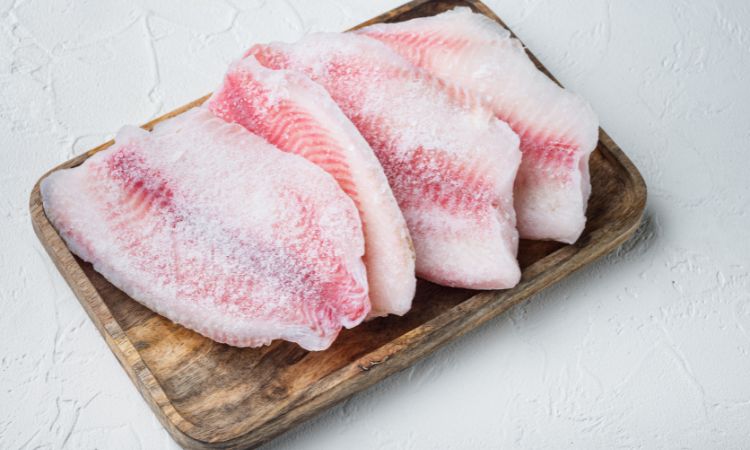In today's digital age, having a strong online presence is crucial for businesses to succeed.…

Health Benefits of Frozen Seafood: Why It’s a Smart Choice
The global frozen seafood market size reached approximately USD 28.00 billion in 2023. The market is further projected to grow at a CAGR of 4.8% between 2024 and 2032, reaching a value of USD 42.70 billion by 2032. This remarkable growth signifies a significant shift in consumer preferences towards frozen seafood. But beyond the economic aspect, what makes frozen seafood truly intriguing is its array of health benefits. In this comprehensive blog post, we will explore the nutritional value, safety, convenience, sustainability, and delicious possibilities of frozen seafood.
Nutritional Value of Frozen Seafood
Comparison with Fresh Seafood
When it comes to nutrition, many consumers wonder whether frozen seafood can match up to the freshness of the catch of the day. The answer may surprise you. Frozen seafood often retains its nutritional value better than its fresh counterparts. This is because freezing seafood immediately after harvest preserves essential nutrients. The quick freezing process locks in vitamins and minerals, making frozen seafood a nutrient-rich choice.
Preservation of Nutrients Through Freezing
During freezing, seafood is exposed to extremely low temperatures, which slows down enzymatic reactions and bacterial growth. As a result, the essential nutrients such as vitamins B and D, as well as minerals like selenium and zinc, are largely retained. This means that when you consume frozen seafood, you are still getting a significant amount of these vital nutrients.
Key Vitamins and Minerals in Frozen Seafood
- Omega-3 Fatty Acids: Omega-3 fatty acids are perhaps one of the most well-known health benefits of seafood. They are essential for heart health, reducing inflammation, and supporting brain function. Frozen seafood, particularly fatty fish like salmon, mackerel, and trout, is rich in omega-3s.
- Protein: Seafood is a high-quality source of protein. Whether it’s shrimp, cod, or tilapia, frozen seafood is packed with protein that is necessary for muscle maintenance and growth.
- Vitamins: Frozen seafood is a good source of essential vitamins such as vitamin D, which is crucial for bone health, and vitamin B12, important for nerve function and red blood cell production.
Low Risk of Contaminants
How Freezing Reduces Contamination Risk
One of the significant concerns with seafood is the risk of foodborne illnesses due to contamination. However, the freezing process can significantly reduce this risk. When seafood is frozen, the cold temperatures inhibit the growth of harmful bacteria and parasites. This is why frozen seafood is often considered safer than fresh seafood.
Regulatory Standards and Safety Measures
To ensure the safety of frozen seafood products, regulatory agencies like the FDA have stringent standards in place. These standards cover everything from processing facilities to transportation to labeling. When you purchase frozen seafood from reputable sources, you can be confident that it has undergone rigorous quality and safety checks.
Tips for Ensuring Safe Consumption
While frozen seafood is generally safe, it’s essential to take proper precautions during handling and cooking to further minimize any potential risks. Here are some tips for ensuring safe consumption:
- Always thaw frozen seafood in the refrigerator to prevent bacterial growth.
- Cook seafood to the recommended internal temperature, typically 145°F (63°C).
- Avoid cross-contamination by washing hands, utensils, and surfaces after handling raw seafood.
- Be mindful of any recalls or warnings related to specific seafood products.
Convenience and Accessibility
The Convenience Factor
Frozen seafood offers unmatched convenience for consumers. It is available year-round, eliminating the need to wait for seasonal availability. This makes it possible to enjoy your favorite seafood dishes whenever you please. Whether it’s succulent shrimp, flaky cod fillets, or tender scallops, you can have them in your freezer, ready to cook at any time.
Reduced Food Waste
One of the hidden benefits of frozen seafood is its role in reducing food waste. With frozen seafood, there’s no rush to use it before it spoils, as is often the case with fresh seafood. This means less food ends up in the trash, helping both your wallet and the environment.
Fits into Busy Lifestyles
In today’s fast-paced world, convenience is paramount. Frozen seafood fits seamlessly into busy lifestyles. After a long day at work, you can come home and have a nutritious seafood dinner on the table in no time. It’s a quick, easy, and healthy option for families and individuals alike.
Sustainability Considerations
Sustainable Fishing Practices
The sustainability of seafood is a critical concern in today’s world. Overfishing and destructive fishing methods can harm marine ecosystems and deplete fish populations. However, the frozen seafood industry has made significant strides in adopting sustainable fishing practices.
Choosing Sustainably Sourced Products
When shopping for frozen seafood, look for certifications and labels indicating sustainable sourcing. Organizations like the Marine Stewardship Council (MSC) certify products that meet strict sustainability standards. By choosing such products, you are supporting responsible fishing practices and the long-term health of our oceans.
Impact on Marine Ecosystems
Sustainable seafood practices focus on maintaining the balance of marine ecosystems. This means that the fish and seafood you enjoy today will still be available for future generations. It’s a win-win for both consumers and the environment.
Cooking Tips and Recipes
Suggestions for Cooking Frozen Seafood
Cooking frozen seafood can be a breeze with the right approach. Here are some tips for getting the best results:
- Thaw seafood in the refrigerator for even cooking.
- Use a variety of cooking methods, from grilling and baking to pan-searing and steaming, to keep things exciting.
- Experiment with different seasonings, herbs, and marinades to enhance the flavor of your seafood dishes.
Read More Articles
lithium iron phosphate battery manufacturers
Quick and Easy Recipes
Frozen seafood lends itself to a wide range of quick and easy recipes. Here are a few ideas to spark your culinary creativity:
1. Sheet Pan Baked Cod with Vegetables
- Preheat your oven to 400°F (200°C).
- Place frozen cod fillets and a mix of your favorite vegetables on a sheet pan.
- Drizzle with olive oil, sprinkle with seasoning, and bake for 15-20 minutes until the cod flakes easily with a fork.
2. Shrimp Stir-Fry
- Heat a pan over medium-high heat with a bit of oil.
- Add frozen shrimp and stir-fry with your choice of vegetables and a stir-fry sauce until the shrimp turn pink and opaque.
- Serve over rice or noodles.
3. Salmon and Asparagus Foil Packets
- Lay out a sheet of aluminum foil and place a frozen salmon fillet on it.
- Add asparagus spears, lemon slices, and your choice of seasonings.
- Fold the foil into a packet and bake at 400°F (200°C) for 15-20 minutes.
Conclusion
In conclusion, the global frozen seafood market is on a trajectory of impressive growth, projected to reach USD 42.70 billion by 2032. This surge in popularity is not without reason. Frozen seafood offers a multitude of health benefits, making it a smart choice for consumers looking to enjoy delicious, nutritious, and convenient meals.
From the preservation of essential nutrients through freezing to the reduced risk of contaminants, the advantages of frozen seafood are clear. Its accessibility, reduced food waste, and suitability for busy lifestyles further solidify its place in the modern kitchen. Moreover, the commitment to sustainable fishing practices ensures that you can enjoy frozen seafood guilt-free, knowing that you are contributing to the preservation of marine ecosystems.
So, the next time you reach for that bag of frozen shrimp or salmon fillet, remember that you’re not only making a practical choice but a healthy one too. With the right cooking techniques and recipes, you can savor the delights of frozen seafood and reap the rewards of its nutritional bounty. It’s time to embrace frozen seafood as a cornerstone of your culinary repertoire, offering both taste and health in every bite.




This Post Has 0 Comments